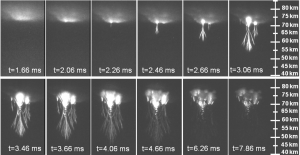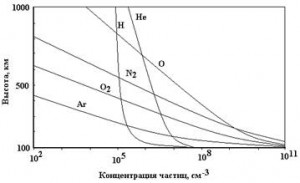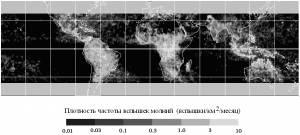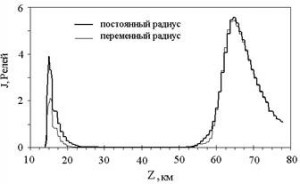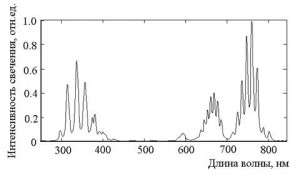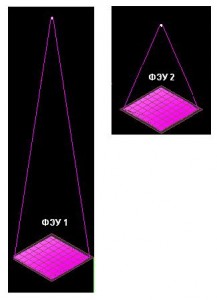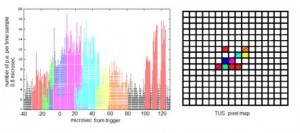Transient luminuos events in the atmosphere
What is it?
In the upper atmosphere between the clouds and the ionosphere (at the altitudes of 10-70 km) short-term (from one up to hundreds milliseconds duration) bursts of electromagnetic radiation within wide spectral ranges (from visible light up to UV and even X-ray and gamma radiation) are observed. Glowing is observed at the area of dozens and even hundreds kilometers.
Examples of transient events observation by measn of video cameras.
Fig. 1. Innovative technology of fast recording (5000-10000 frames per second) allows to follow the development of the discharge (Cummer et al (2006), Submillisecond imaging of sprite development and structure, Geophys. Res. Lett., 33, L04104, doi:10.1029/2005GL024969).
Short duration of the bursts point out their origin from electric discharges which develop in the atmosphere at high velocity (of light velocity order). Such high speeds of the discharge evolution are reached in lightning (strimmer) discharge where photons play a role of “leaders”. If a number of conditions specific for the upper atmosphere (with low matter density) are accomplished at electric field burst, conditions for the electrons accelaration up to relativistic energy (over 1 MeV) are established and these electrons become discharge “leaders”. Part of accelerated electrons can be captured by geomagnetic field and be caught in a magnetospheric trap balancing between the discharge point and conjugate point till their energy is spent for the ionosphere ionization. Effect of electrons’ balancing in the magnetosphere is thoroughly studied in the Earth’s outer radiation belt. In case of discharge with electron acceleration electron lifetime in the magnetosphere is significantly smaller (an order of minutes) than in the radiation belt (an order of days).
Atmosphere structure.
General information about the structure and composition of the atmosphere and about the global electric field in it will be recollect below.
It is accepted to separate atmosphere into several parts with specific characters. Atsmospere structure, pressure and temperature curves from altitude are presented in Fig. 2. Full thickness of the atmosphere’s matter is 1000 g/cm2 (pressure at sea level is 1000 mbar), atmosphere’s density decreases with altitude’s increase according to exponential law. Up to the altitudes of about 100 km composition of the atmosphere is quiet stable – it is a mixture of nitrogen (78%) and oxygen (21%) impured with other gases (the larges fracture is argon 0 about 1%), water vapours and dust partcles (aerosols). Approximately half of the atmosphere’s mass is concentrated in the troposphere (at the altitudes of up to 8-9 km). Water vapours and ice partciles together with the most part of the aerosols produced by soil rotting and human activity are out here. Water vapour and ice particles form clouds and giant cloud masses which (see below) play an important role in the electric processes in the atmosphere. In the troposphere temperature decreases fast with altitude decreasing (near the sea and ground level temperature of the atmosphere is determined by the temperature of the Eart’s surface heated by the Sun). In the stratosphere (at the altitude of 10-50 km) atmosperic pressure is one-two orders of magnitude lower than in troposphere. At the same main gas composition as in troposphere, in stratospere ozone layer (oxygen molecule О3 ) responsible for absorbtion of UV radiation with wavelength λ<300 nm plays an important role. Temperature of the stratospere increases with altitude due to increase of solar UV intensity.
Fig. 2. Structure of the atmosphere. Right axis – altitude of the atmosphere, left axis – pressure (mbar).
Mesosphere and thermosphere are located higher than stratosphere. There layers of the ionosphere (ions of atoms and molecules, whose origin is discussed below) are situated. Ionosphere plays the most important role in the Earth’s electric processes. It’s necessary to mention that ions of the ionosphere are onle a small part (about 10-5) of the total mass of the ionosphere which consists of the same molecules as the lower part of the atmosphere.
At the altitude over 100 km (exosphere) atmospheric composition changes dramatically (see Fig. 3). Beginning from the altitude of 200 km atomic oxygen plays the most important role in it. At the higher altitudes, over 800 km (magnetosphere) helium and hydrogen become the main elements of the atmosphere.
While in the troposphere the most important solar effect is the heating of the Earth’s surface, in the upper atmosphere the most important effect is atmospheric absorption of UV, X-ray and charged solar particles. These solar “radiations” not onle heat the upper atmosphere, but also change its molecular and ion composition.
Fig. 3. Composition of the atmosphere at the altitudes over 100 km.
In the upper atmosphere solar UV and X-ray radiation flux ionize atoms and molecules. Recombination rate of the ions and electrons in the rare atmosphere is not high and a layer of ions is formed here (in fact there are several layers of ions of different charges and masses). Gravity and the Earth’s rotation capture the ions and as a result ion charge rotate in the magnetic field of the Earth. It causes appearence of electric field directed perpedicularly to the magnetic force lines. At the equator where magnetic force lines are in-parallel to the Earth’s surface electric field is directed vertically to the Earth. Moon’s gravity also influence on the movement of the ions, though small “tidal” effects in the electric field of the Earth are expectable.
Potential of the electric field of the Earth varies from 200 up to 400 kV. In the cloudless regions of the Earth the atmosphere is low conductive and mean current here is about 4 10-12 A/ m2 (current avergaed over the Earth is about ~140 kA), so the power of the Earth electric generator at the average is about 105 MW.
Lightning discharges in the atmosphere are an affective source of the ions (on a balance this source also gets energy from the Sun).Globally in the Earth’s atmosphere there are about 2000 continuously acting thunderstorm formations, and frequency of lightnings is about 30 per second. Distribution of the active zone of thunderstorm phenomena over the Earth’s surface during nothern hemisphere winter (December – February) (GHCC Lightning Research Overview, 2000).
Fig. 4. Distribution of the lightnings frequency over the Earth’s surface. Grey color intensity grows with increase of the lightning observation frequency. The data from GHCC Lightning Research Overview, 2000, during December – February. It is seen that the main tendency of the distribution is correlation of lightning frequency with continents in the tropical region of the Earth.
Geographic maximum of the lightning activity is situated in the equatorial region of Africa, South America and Indonesia-Australia. Maximum of lightning frequency happen to be at 18 UT. Such non-regular distribution of the ion source over the Earth map and time makes an electric field of the Earth also non-regular, but strong global winds in the upper atmosphere lead to fast distribution of the ions over all the Earth’s surface, so the global electric field is sufficiently regular and has a maximum in the equatorial region.
A number of ions in the ionosphere is enriched due to other sources. Galactic cosmic rays of relatively high energy (mean energy of 10 GeV) are a “space” source of the ions. They produce ions across the atmosphere with maximum at the altitude of about 15 km. Radioactive elements in the Earth crust which ionize the atmosphere near the Earth’s surface is one more source. Radioactive gas Radon (maximum of ionization is situated at the altitude of hundreds meters) plays a specific role among them.
Historically lightning observations were the first observations of bursts (discharges). The founder of Moscow State University M.V. Lomonosov paid great attention to this phenomenon. Local propertu of the lightning discharge is its characteristic feature (lightning’s filament always has small cross size although its length can reach several kilometers). However long ago it was noticed that lightning discharges can be of different type, and there are also discharges of quiet different type which appear in the atmosphere. Typical feature of such discharges are its diffusion luminiscence occupying big area and lack of “thunderstorm”, i.e. absence of fast local temperature increasing in the discharge region (“cold” discharge). As it was shown above (see example of the transient phenomenon) spatial form of the discharges and their time evolution are extremely different. By means of detectors which can observe color of the luminiscence or (even better) measure spectral composition of the irradiated light the data about the changes of the discharge’s luminence color within the wide range from visual and near UV in the low part of the atmosphere (up to the altitude of 50 km) to mostly red in the upper atmosphere (at the altitudes over 50 km). The most part of the discharges are characterized by short duration of the splashes (about 1-100 ms). For some discharges intensive UV radiation (near UV at wavelengths of 300-400 nm), X-ray and gamma-radiation are observed.
How transient event are explained today?
Mechanisms of the discharges in the upper atmosphere were suggested before the discovery of the discharges themselves. Initially the nature of the discharges in the atmosphere was studied basing of the knowledge about the gas discharge obtained in laboratory conditions – in gas-discharge tubes. In such a classical approach the discharge starts from the threshold value of electric field Еthr, which is proportional to the gas (atmospheric) pressure. On the assumption of the lightning discharge there is an additional splash of field related to redistribution of charge between the cloud and the Earth’s surface which appears besides the constant field directed vertically. It provide the conditions for breakdown of the space between the cloud and the ionosphere, where atmospheric pressure is small.
The calculations of the electric discharge in the atmosphere include predetermined model of electric field distribution in the atmosphere, charge and size of the cloud (disc), its altitude, duration of the lightning discharge. Calculations gives the characteristics of electron shower and characteristics of optic rediation related to the excitation of the molecules and atoms of the atmosphere. In the rare upper atmosphere secondary electrons of low energy (dozens and hundreds of eV) on one hand, dissapear in the collisions with molecules and atoms of the atmosphere, but on the other hand, they are accelerated by the electric field and the energy of the electric field transforms to the energy of atmospheric glow. The calculations have shown that the energy of the electric field generated by the lightning discharge is efficiently spent on ionization and luminescence in the upper atmosphere (at the altitudes of about 60-70 km).
Fig. 5. Altitudinal distribution of the averaged discharge brightness. From the thesis by Yu.A. Kudryavtsev, Sarov, 2005.
Calculated radiation spectrum at this altitudes is shown on Fig. 6.
Fig. 6. Radiation spectrum in the discharge of sprite type, calculations by Milikh et al, 1998. Spectrum of Red Sprites , J. Atm. Terr. Phys., 69, 907-11.
Really registered color of the discharge depends on spectral sensitivity of the operated detector. For the most part of used video cameras the range of registered light covered λ=430-850 nm, and they could not detect the significant part of the radiated light – near UV (300-400 nm). Near UV was registered during the experiments onboard the MSU satellites “Universitetskij – Tatiana” and “Universitetskij – Tatiana – 2”, and the resluts conformed the spectrum in Fig. 6.
New detectors of “Mikhailo Lomonosov” satellite
Are the assuptions on the beginning of the electron shower evolution and on the role of different factors right – it is an open issue, because there are still no experimental information about the initial stage of the discharge. TUS detector onboard “Mikhailo Lomonosov” satellite will be the first one which will make it possible to observe the luminescence at the very early stage due to giant aperture of the instrument (2 sq.m., thousands time more than aperture of videocameras) and sufficient spatial resolution (4-5 km). At the same time big aperture of TUS detector does not allow to observe luminescence at the stage of its maximum (photoreceiver of the detector is saturated), therefore the equipment includes two video cameras with simple optics of point opening (pinhole camera) which will register luminescence in its maximum. The cameras has different focal distances in order to get images of luminescence object in two different scales, see Fig. 7.
Fig. 7. Pinhole cameras with different focal distances. Photoreceiver is 64-anode photoelectronic multiplyer.
Devices of both types (TUS and pinhole cameras) are operated within the range of near UV (300-400 nm).
Expected signals in the basic instrument TUS and pinhole camera are shown in Fig. 8.
Fig. 8. Signals in TUS detector. Time diagram of the signal in separate channels of photoreceiver (left), and the map of the deployed channels (right). The beginning of the electric discharge evolution (red lines) starts after the evolution of the Auger shower, which finishes in 100 mks.
Fig. 9. Discharge signals in pinhole camera at the later stage comparing with signal in TUS detector.
Why is it important?
Up-to-date experimental data on the discharges in the upper atmosphere show that the phenomenon of the discharges in the upper atmosphere itself has global character, number of discharges and energy liberated in these discharges are so huge that we have a right to expect certain relations between the discharge phenomenon and other geophysical phenomena. The mechanisms explaining the appearence of the discharges means that the discharges in the upper atmosphere, electric field of the Earth and its ionosphere are surely interrelated. All factors influencing on the electric field and the ionosphere of the Earth (magnetospheric conditions, number of thunderstorms, “tidal” forces of the Earth and the Moon) can also influence on the frequency of the discharges and, probably, on the brightness spectrum of the discharges, spectral composition of electromagnetic radiation in the discharges.
One more interesting question concerns the possibility for the outcom of part of high-energy electrons into the radiation belts of the Earth and, vice versa, electrons precipitation from the radiation belt at irragularities of the Earth’s electromagnetic field at the moment of the discharge in the upper atmosphere.
Up-to-date evaluations of the energy liberated in the discharges in the upper atmosphere give a value of about 1012 J per day (several microwatts per m2), which is small comparing with total kinetic energy in the mesosphere, but they can influence on mesospheric conditions due to produced powerful local effects.
Discharges in the upper atmosphere can essentially influence on the chemical composition of the upper atmosphere. Before the studies of the discharges in the upper atmosphere it was considered that cosmic rays are the main reason for dissociation of nitrogen molecules in the upper atmosphere and production of nitrogen oxide NO. NO and NO2 complexes are important for the upper atmosphere due to generation of ozone (О3). This process is vitally important because it compensate ozone’s loss during solar UV absorbtion. Taking into account high energy input by discharge electrons into the upper atmosphere, probably, these discharges are the main source of nitrogen dioxide.
In general, dсischarge electrons in the upper atmosphere can essentially change the balance of molecular and atomic composition of all elements of the upper atmosphere
Experimental data do not exclude influence of exhaulation of radioactive radon (decay of its atoms produce electrons necessary for the beginning of the electric discharge) on the frequency of the dischrges in the certain region. It is known that quantity of separated radon depends on seismic activity of the studied region, so the frequency of the transient events can be a factor of the increased seismic activity.
Studies of transient events is also important from the point of safety of the stratospheric flights. In rare cases of extremely powerful electric deischarges intensity of the electrons with the energy sufficient for the penetrating through the plane’s body can cause ionization inside it, which is dangerous both for the equipment and for the health of the people.
 Lomonosov
Lomonosov